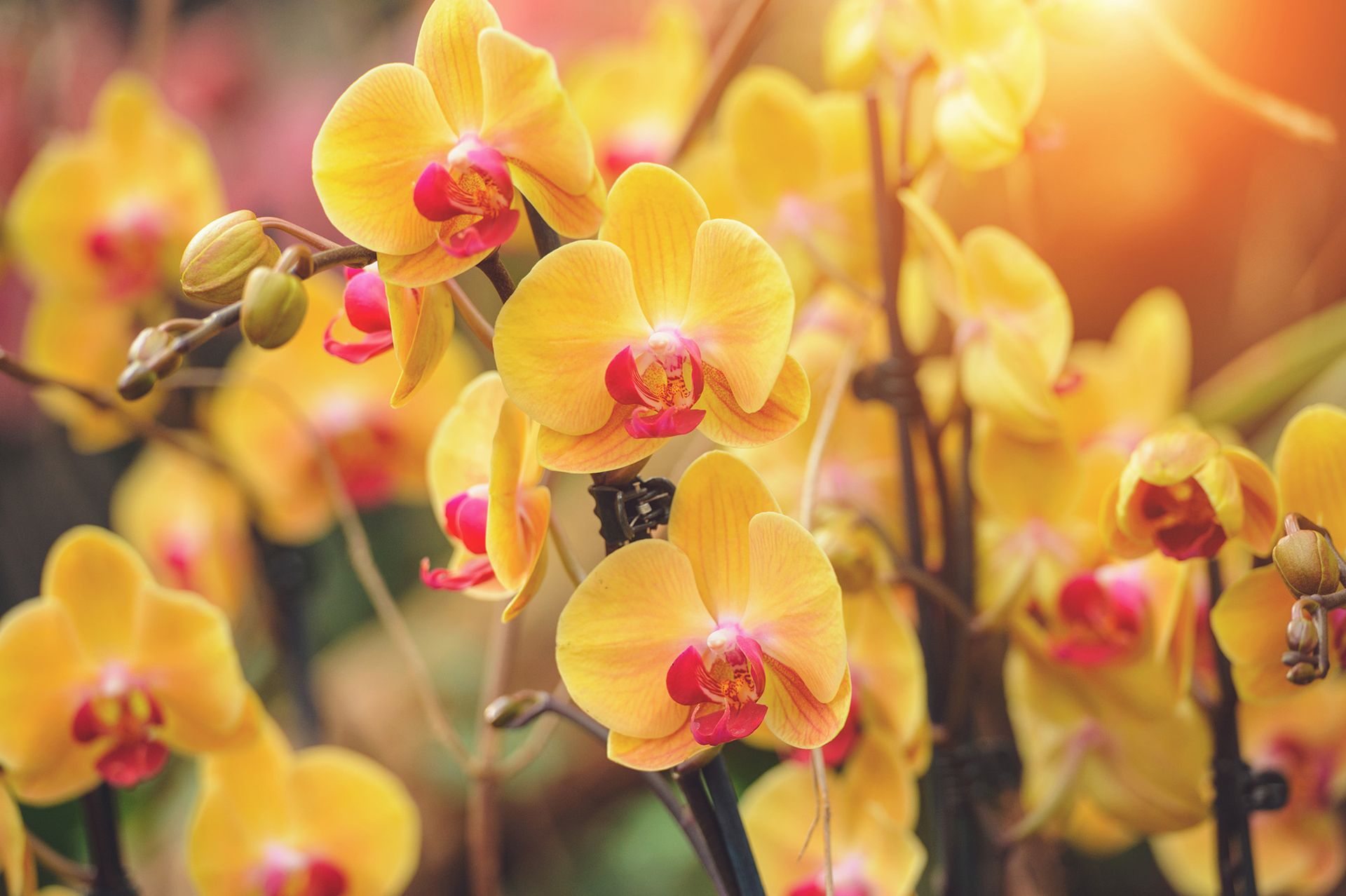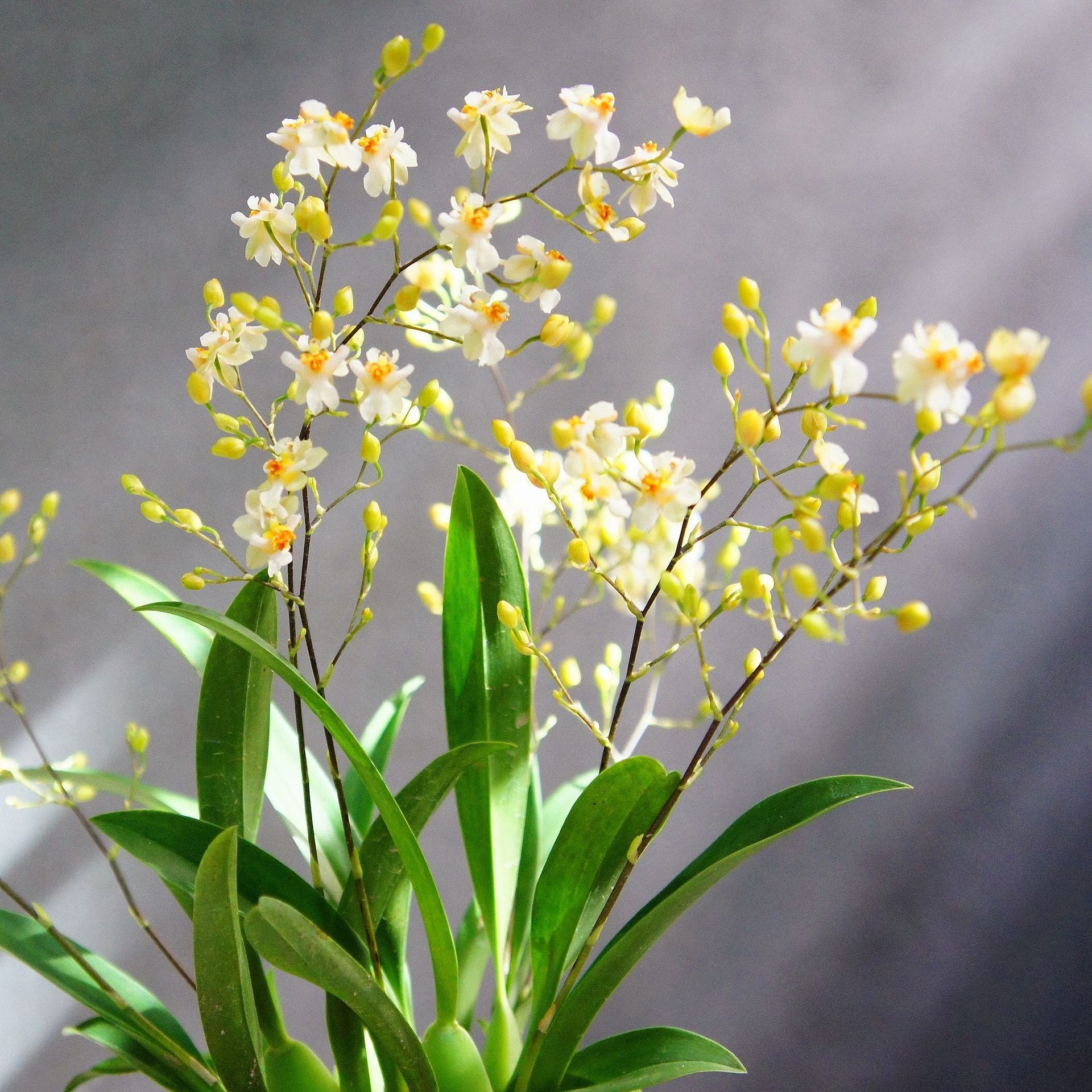Orchid care: all your questions, answered
The experts reveal their best orchid care tips, to keep these exotic houseplants thriving and blooming for years to come
- (opens in new tab)
- (opens in new tab)
- (opens in new tab)
- Sign up to our newsletter Newsletter


Orchid care is notoriously particular, given the plant's preference for a rigid set of light, humidity, and temperature standards. But once you understand the proper conditions to help your orchid thrive, orchids can be quite straightforward to maintain.
Often listed amongst the top indoor plants, orchids are native to tropical climates, orchids like warmth, so make sure they are kept out of cold drafts.
‘While people can often be intimidated by orchid maintenance, in reality these tropical flowers are very easy to care for,’ says Paige Harmon at Westerlay Orchids (opens in new tab).
‘Finding just the right area in your home that provides the best light and temperature is the first step to good orchid care. But of equal importance is appropriate and timely watering.’

Orchid care essentials
While orchid care is not particularly time-consuming, you do need to know the correct way to look after them, to avoid being faced with an orchid wilting. Follow these expert tips to ensure your orchid stays in good health and flowers reliably.
1. Understand orchid types
‘Orchid care seems to be a complicated issue, but it doesn’t need to be – the secret is to know what type of orchid it is, and once you provide it with the right conditions, it will look after itself,’ says Valeria Valkova, head of the nursery at world-famous grower McBean's Orchids (opens in new tab).
‘Orchids are one of the largest plant families, yet out of the tens of thousands of species, fewer than 100 species and a handful of genera are widely commercially grown. These include phalaenopsis, dendrobium, cymbidium, paphiopedilum, cattleya, and oncidium,’ says Brad Biren, an experienced botanist with a specialty in orchidology.
He explains that dendrobium, cattleya, cymbidium, and oncidium belong to the same ‘tribe’, requiring similar care, while phalaenopsis and paphiopedilum orchids have slightly different needs.
If you aren’t sure, Biren suggests looking at the stems and leaves. To identify the dendrobium ‘tribe’, ‘imagine all of your orchids that have canes, pseudobulbs, or a very clear stem.
'Phalaenopsis has mostly large big floppy leaves and an almost indistinct stem. Paphiopedilum or lady slipper orchids have longer narrower leaves and are by far the most challenging within this group.’
2. Check your orchid’s temperature range
Temperature requirements vary between different orchid types, but getting it right is an important aspect of orchid care.
‘Their preferred temperature very much depends on plant origins – for example, moth orchids (phalaenopsis) are tropical and warm-growing, while cymbidiums are from the Himalayas and tolerate much cooler conditions,’ says Valkova.
In general, Harmon recommends that for most orchids the best range is 65-80°F while blooming. However, there is variation between different species, while orchids also benefit from a slightly lower temperature at night (10-15°F cooler).
For more information on the temperature requirements of your specific orchid variety, check the resource center at American Orchid Society (opens in new tab).
While your orchid may tolerate some degree of being too warm or too cold, be careful this isn’t for a prolonged period.
‘Heating improperly will lead to adverse side effects for your orchids, including causing their tissue to dry out and wither prematurely, or creating way too many flowers all at once – therefore overpopulating the plant with blooms, says Lindsey Hyland, founder of Urban Organic Yield (opens in new tab).
'This will leave it stressed and overwhelmed, unable to support its weight, so it will topple over in its pot. Conversely, if you don't provide adequate heat for your plants, the flowers will fail.'
If you're wondering Why is my orchid stem turning yellow?' this may not be due to environmental factors, however.

3. Get the best light for orchids
Similarly to temperature, when it comes to how much light an orchid should receive, it's important to know where the orchid originates from.
‘Moth orchids and cool-growing oncidiums will require much less light than vandas or dendrobium,’ says Valkova.
Orchids tend to prefer indirect light, and can also grow in bright rooms away from the window, though some exposure to sunlight is ideal.
‘It is hard to give a phalaenopsis orchid too much indirect light,’ says horticulturist Shannon Caringi at Trillium Living (opens in new tab).
‘Orchids prefer a location in the home that faces south or east. Windows that face west can be too hot and sunny during the summer months. However, they may be perfect in cooler seasons.’
Keep an eye on your orchid’s leaves, as they are a good indicator of whether it is receiving enough light, or the temperature isn’t right.
‘Orchid leaves can become sunburned, so avoid placing them in hot, direct sun. Similarly, the leaves can freeze if they come into contact with a cold window in winter,’ adds Caringi.
‘Orchids with dark green leaves are not receiving enough light, while light green leaves with yellow tones indicate that the orchid is receiving enough light to bloom.’
4. Check the humidity
Orchids like a humidity range of between 40-70 percent, which is more humid than most homes.
If you only have a few orchids, then you can increase the humidity in that area by using humidity trays filled with gravel, or even just adding a few more houseplants nearby.
If you have a number of orchids, then you may want to consider investing in a humidifier, although this risks introducing condensation and mold into the home.
When humidity is high, air movement is key, so a fan in the room – not pointed directly at the orchids – will keep them happy.
Perhaps the most low-maintenance spot for an orchid in your home? The bathroom. The humidity given off from regular showers and baths can be enough to sustain orchid-friendly humidity levels.

5. Don't overwater orchids
Knowing when and how much to water orchids is one of the more difficult aspects of orchid care to master.
‘Orchids are far more often overwatered than underwatered,’ says Harmon. ‘For plants grown in bark, water once per week at most, and only if the potting medium is dry.
'Phalaenopsis grown in sphagnum moss need water less frequently – every 10 days should be sufficient. Be sure to water moss thoroughly, since moss that is very dry may not immediately absorb water.’
‘Orchids hate to sit too wet,’ adds Valkova. ‘There are many techniques and everyone will find the one that's just right. I recommend watering the pot in a deep container until it's submerged and leave for 5-10 minutes until the bark is fully soaked – but never water the orchid crown (center of the leaves). Remove the plant to drain completely.
She advises repeating once the bark is dry and the roots are silvery-grey.
Caringi recommends focusing the water only on the potting mix and the orchid’s roots, avoiding leaves and flower stalks. ‘A watering can with a narrow spout is helpful,’ she says.
‘Although it won’t inherently hurt the plant to get water on the leaves, I find that I have fewer problems with leaf diseases and crown rot issues when I keep the leaves dry.’
Orchids benefit from a mild fertilizer at every other watering. You can buy specific orchid feed, or Harmon recommends using a general balanced fertilizer such as Grow More 20-10-20 at half the normal dose.
The seasons will also affect how often your orchid will need to watered. You'll find it needs less watering in the cool winter months, and more during the warm summer months.
6. Pruning orchids
Wondering how to prune orchids? Orchids don't need to be trimmed, but if flowers go brown and dry, you can cut them off.

7. Repotting an orchid
It's important to know the signs of when to repot orchids.
Unlike many other plants, orchids respond well to their roots being restricted, so there’s no need to buy a much larger pot.
‘Always use a pot that is only slightly larger than the current pot,’ adds Hyland. ‘Too much space will encourage the plant to grow more roots, which can be difficult to manage. When you do repot, make sure to gently loosen the roots and spread them out in the new pot before adding fresh potting mix.’
When repotting your orchid, you may notice some of the roots have dried up or rotted.
‘Take the pot away from the plant carefully and wash the roots away. Then trim off any brown or rotting roots with sharp scissors,’ says Nikita, founder of Mit City Farm (opens in new tab).
‘Fill the new planter halfway with moist potting material and set the plant such that the base is level with the medium. Push pieces of planting medium between the roots with a chopstick.
‘When repotting, use extreme caution. Root damage can be lethal, and blemishing fresh flower stems can impede blossoming.’
Should you trim orchid roots when repotting?
When repotting, you should trim off any dead, dried up roots, but leave the healthy roots intact.
‘Orchid roots are photosynthetic and should never be trimmed or pruned,’ says Biren. ‘If they are too unruly looking, consider covering the top of the potting medium with moss and then using floral wire to secure the roots to the top of it. It will give the plant an older, more mature appearance.’

What should I do after flowering?
‘After flowering, you can cut back the spike, but leave at least one node on the spike and it can encourage flowering again in a few months from that node,’ says George Tandt, founder of Teak & Terracotta (opens in new tab).
‘Once the whole spike has died back you can cut it off at the base. The orchid will then put energy into new leaf growth.
‘At this stage you can move the plant to a colder spot, like next to an open window. The cold can trigger new spike growth, which should start in winter time in its natural environment.’
How do I get an orchid to bloom again?
‘If the plant has right growing conditions, it will recreate its natural cycle and flower again. This will not happen immediately and it might take up to a year for the plant to adapt to its environment and rebloom,’ says Valkova.
‘I recommend using two types of orchid feed: one to support growth, the other to support flower. and leave the plant to do the rest.’
Is watering orchids with ice cubes a good idea?
There is a widespread idea that placing 2-3 ice cubes on top of the potting medium is a good way to gently give orchids the water they need.
‘While this is an easy and simple way to water, it may not be the best long-term alternative as orchid roots need a thorough drenching to wash away excess fertilizer salts,’ says Caringi.
‘Also, you should avoid placing ice cubes directly on exposed roots and leaves as this can cause frost damage.’

Should you mist an orchid?
Misting orchids can be beneficial and help improve humidity if your home tends to be on the dry side. However, if the orchid is excessively misted, then it can cause fungal growth and rot, especially in an already humid environment.
So, mist lightly and don’t do it as a replacement for watering.
What is the best orchid to buy?
‘I recommend phalaenopsis orchids for beginners,’ says Caringi. ‘Although they appear fragile they are quite adaptable and perform well in most indoor environments.
If you live in a cooler climate, then cymbidiums are more cold tolerant than other orchid types.
How do you know if an orchid is good?
‘When selecting an orchid, choose plants with a strong flower stalk and plenty of unopened flower buds. This ensures a long bloom time. Leaves should be clean and free from blemishes and dark spots,’ says Caringi
‘They should also appear full and plump. Wrinkled leaves indicate that the plant hasn’t been watered properly and is dehydrated.’

As editor of Period Living, Britain's best-selling period homes magazine, Melanie loves the charm of older properties. I live in a rural village just outside the Cotswolds in England, so am lucky to be surrounded by beautiful homes and countryside, where I enjoy exploring. Having worked in the industry for almost two decades, Melanie is interested in all aspects of homes and gardens. Her previous roles include working on Real Homes and Homebuilding & Renovating, and she has also contributed to Gardening Etc. She has an English degree and has also studied interior design. Melanie frequently writes for Homes & Gardens about property restoration and gardening.
-
-
 Valentine's Day gift ideas 2023: 24 last-minute luxuries for your loved ones
Valentine's Day gift ideas 2023: 24 last-minute luxuries for your loved onesFrom the timeless beauty of a traditional bouquet of flowers to unique houseplants and fun sweet treats, our selection of Valentine's Day gift ideas will be sure to inspire
By Zara Stacey • Published
-
 Robert Pattinson just bought a Spanish Colonial-style home – with an interior designer past
Robert Pattinson just bought a Spanish Colonial-style home – with an interior designer past'The Batman's' Robert Pattinson and Suki Waterhouse purchased the Jeff Lewis-designed Hollywood Hills estate for $5.3 million
By Megan Slack • Published

